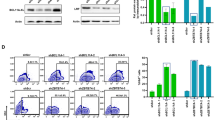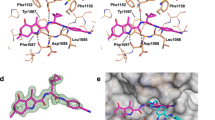Abstract
The application of RNA interference (RNAi) to stem cell–based therapies will require highly specific and lineage-restricted gene silencing. Here we show the feasibility and therapeutic potential of coregulating transgene expression and RNAi in hematopoietic stem cells. We encoded promoterless small-hairpin RNA (shRNA) within the intron of a recombinant γ-globin gene. Expression of both γ-globin and the lariat-embedded small interfering RNA (siRNA) was induced upon erythroid differentiation, specifically downregulating the targeted gene in tissue- and differentiation stage–specific fashion. The position of the shRNA within the intron was critical to concurrently achieve high-level transgene expression, effective siRNA generation and minimal interferon induction. Lentiviral transduction of CD34+ cells from patients with sickle cell anemia led to erythroid-specific expression of the γ-globin transgene and concomitant reduction of endogenous βS transcripts, thus providing proof of principle for therapeutic strategies that require synergistic gene addition and gene silencing in stem cell progeny.
This is a preview of subscription content, access via your institution
Access options
Subscribe to this journal
Receive 12 print issues and online access
$209.00 per year
only $17.42 per issue
Buy this article
- Purchase on Springer Link
- Instant access to full article PDF
Prices may be subject to local taxes which are calculated during checkout




Similar content being viewed by others
References
McCaffrey, A.P. et al. RNA interference in adult mice. Nature 418, 38–39 (2002).
Scherer, L. & Rossi, J.J. Therapeutic applications of RNA interference: recent advances in siRNA design. Adv. Genet. 52, 1–21 (2004).
Ill, C.R. & Chiou, H.C. Gene therapy progress and prospects: recent progress in transgene and RNAi expression cassettes. Gene Ther. 12, 795–802 (2005).
Steinberg, M.H. & Rodgers, G.P. Pathophysiology of sickle cell disease: role of cellular and genetic modifiers. Semin. Hematol. 38, 299–306 (2001).
Sledz, C.A., Holko, M., de Veer, M.J., Silverman, R.H. & Williams, B.R. Activation of the interferon system by short-interfering RNAs. Nat. Cell Biol. 5, 834–839 (2003).
Pebernard, S. & Iggo, R.D. Determinants of interferon-stimulated gene induction by RNAi vectors. Differentiation 72, 103–111 (2004).
Matsumoto, S., Miyagishi, M., Akashi, H., Nagai, R. & Taira, K. Analysis of dsRNA-induced apoptosis pathways using IFN response-noninducible siRNA-expression vector library. J. Biol. Chem. (2005).
Unwalla, H.J. et al. Negative feedback inhibition of HIV-1 by TAT-inducible expression of siRNA. Nat. Biotechnol. 22, 1573–1578 (2004).
Song, J. et al. Gene silencing in androgen-responsive prostate cancer cells from the tissue-specific prostate-specific antigen promoter. Cancer Res. 64, 7661–7663 (2004).
May, C. et al. Therapeutic haemoglobin synthesis in beta-thalassaemic mice expressing lentivirus-encoded human beta-globin. Nature 406, 82–86 (2000).
Buratti, E. & Baralle, F.E. Influence of RNA secondary structure on the pre-mRNA splicing process. Mol. Cell Biol. 24, 10505–10514 (2004).
Kim, D.H. et al. Synthetic dsRNA Dicer substrates enhance RNAi potency and efficacy. Nat. Biotechnol. 23, 222–226 (2005).
Le Hir, H., Izaurralde, E., Maquat, L.E. & Moore, M.J. The spliceosome deposits multiple proteins 20-24 nucleotides upstream of mRNA exon-exon junctions. EMBO J. 19, 6860–6869 (2000).
Zeng, Y. & Cullen, B.R. Efficient processing of primary microRNA hairpins by Drosha requires flanking non-structured RNA sequences. J. Biol. Chem. 29, 27595–27603 (2005).
Danin-Kreiselman, M., Lee, C.Y. & Chanfreau, G. RNAse III-mediated degradation of unspliced pre-mRNAs and lariat introns. Mol. Cell 11, 1279–1289 (2003).
Williams, B.R. Signal integration via PKR. Sci. STKE 2001, RE2 (2001).
Nathan, D.G. Pharmacologic manipulation of fetal hemoglobin in the hemoglobinopathies. Ann. NY Acad. Sci. 612, 179–183 (1990).
Sadelain, M., Rivella, S., Lisowski, L., Samakoglu, S. & Riviere, I. Globin gene transfer for treatment of the beta-thalassemias and sickle cell disease. Best Pract. Res. Clin. Haematol. 17, 517–534 (2004).
Pawliuk, R. et al. Correction of sickle cell disease in transgenic mouse models by gene therapy. Science 294, 2368–2371 (2001).
Blouin, M.J. et al. Genetic correction of sickle cell disease: insights using transgenic mouse models. Nat. Med. 6, 177–182 (2000).
Lan, N., Howrey, R.P., Lee, S.W., Smith, C.A. & Sullenger, B.A. Ribozyme-mediated repair of sickle beta-globin mRNAs in erythrocyte precursors. Science 280, 1593–1596 (1998).
Xu, X.S., Glazer, P.M. & Wang, G. Activation of human gamma-globin gene expression via triplex-forming oligonucleotide (TFO)-directed mutations in the gamma-globin gene 5′ flanking region. Gene 242, 219–228 (2000).
Graslund, T., Li, X., Magnenat, L., Popkov, M. & Barbas, C.F., 3rd . Exploring strategies for the design of artificial transcription factors: targeting sites proximal to known regulatory regions for the induction of gamma-globin expression and the treatment of sickle cell disease. J. Biol. Chem. 280, 3707–3714 (2005).
Kohn, D.B., Sadelain, M. & Glorioso, J.C. Occurrence of leukaemia following gene therapy of X-linked SCID. Nat. Rev. Cancer 3, 477–488 (2003).
Castanotto, D. & Rossi, J.J. Construction and transfection of PCR products expressing siRNAs or shRNAs in mammalian cells. Methods Mol. Biol. 252, 509–514 (2004).
Gallardo, H.F., Tan, C., Ory, D. & Sadelain, M. Recombinant retroviruses pseudotyped with the vesicular stomatitis virus G glycoprotein mediate both stable gene transfer and pseudotransduction in human peripheral blood lymphocytes. Blood 90, 952–957 (1997).
Li, Q. et al. Differences of globin transgene expression in stably transfected cell lines and transgenic mice. Blood 105, 3346–3352 (2005).
Ercikan-Abali, E.A. et al. Active site-directed double mutants of dihydrofolate reductase. Cancer Res. 56, 4142–4145 (1996).
Nicolini, F.E. et al. Expression of a human beta-globin transgene in erythroid cells derived from retrovirally transduced transplantable human fetal liver and cord blood cells. Blood 100, 1257–1264 (2002).
De Bruyn, C., Delforge, A., Bernier, M. & Bron, D. Ex vivo expansion of neutrophil precursor cells from fresh and cryopreserved cord blood cells. Cytotherapy 5, 87–98 (2003).
Acknowledgements
The authors thank Valentina Motta and Hao Ho for excellent technical assistance. This work was supported by the US National Institutes of Health (grants HL57612, CA08748 and CA59350) and the Leonardo Giambrone Foundation and the Associacione per la ricerca Piera Cutino.
Author information
Authors and Affiliations
Corresponding author
Ethics declarations
Competing interests
The authors declare no competing financial interests.
Supplementary information
Supplementary Fig. 1
Inducible accumulation of transgene expression (PDF 744 kb)
Supplementary Table 1
Sequences of oligonucleotides and PCR primers (PDF 24 kb)
Rights and permissions
About this article
Cite this article
Samakoglu, S., Lisowski, L., Budak-Alpdogan, T. et al. A genetic strategy to treat sickle cell anemia by coregulating globin transgene expression and RNA interference. Nat Biotechnol 24, 89–94 (2006). https://doi.org/10.1038/nbt1176
Received:
Accepted:
Published:
Issue Date:
DOI: https://doi.org/10.1038/nbt1176
This article is cited by
-
Oncolytic adenovirus co-expressing miRNA-34a and IL-24 induces superior antitumor activity in experimental tumor model
Journal of Molecular Medicine (2013)
-
Silencing human genetic diseases with oligonucleotide-based therapies
Human Genetics (2013)
-
High-efficiency Transduction of Rhesus Hematopoietic Repopulating Cells by a Modified HIV1-based Lentiviral Vector
Molecular Therapy (2012)
-
RNAi: a potential new class of therapeutic for human genetic disease
Human Genetics (2011)
-
Correction of Murine Sickle Cell Disease Using γ-Globin Lentiviral Vectors to Mediate High-level Expression of Fetal Hemoglobin
Molecular Therapy (2009)



